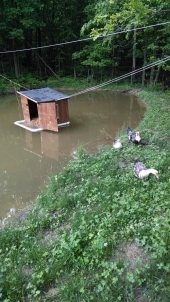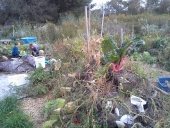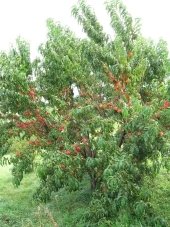I agree, it would be nice with more visual help on projects. Sometimes people just don't do it or forget and not everyone is some kind of YouTube "star". I'm not meaning this to sound b!/(hy but just making a point.
My friend uses a very sort of lax way to start new beds and build more on the older ones. I helped build the first one. She just starts new ones by laying branches and logs down as they are available after a storm or whatever. Yard waste. We also had the benefit of as much straw/goat/rabbit/alpaca manure as we could use when they get to that point. Yes she has to patch holes and stuff that have caved in or left open spots every year. After the chickens found them she started using hay netting to cut down on their damage. She has sort of gotten away from as much gardening because she is so busy with animals so it is someone's and sometimes my job to help along. She gets some volunteers since she really is running an educational farm.
They likely will need water and a nitrogen source to get started the first real growing year. Ours did well with cucumbers and summer squash the first year. It was so nice to have something to neel on or lean into to pick cucs. It was an easy daily project to do and get the right sized ones for canning.There are a ton of grasses growing in it because of the manure. I see that as a benefit as it is real easy to pull or chop and drop them before they turn back to seed.
The beds are dispersed among the orchard making things work real nice for the trees too. Now there is comfrey all around which surely helps. Last year she actually had her Chicago figs grow large and fruit out, northern mi. The fall crop got wasted, the larger crop, because of timing. The micro climate helped I would guess, and the nutrients, but we need to work on a way to get the big harvest. Maybe a wrap of some kind.
I'm already hooked on hugel and plan on doing as much as i can this year. I've had health issues the last couple of years to make up for. Some will be built on top of ground probably if it's a wetter area and the larger log base will get buried in the drier sandier areas of the yard. The whole front yard, about 1/3 of an acre will eventually be a food forest or more accurately an orchard along with bushes and shrubs and strawberries ect. My yard if different than my friends place. We have ducks that can help with any slugs and potato bugs or Japanese beetles ect. I'll have more gardens and some animals (free range ducks, sometimes geese and chicken tractors for me) and she has tons of animals so her garden has been neglected. I'm planning on working at her place too and refresh the gardens in trade for wood or manure or whatever other materials I can find there. Lots of perennial plants with seed crops scattered here and there.
I would definitely fill in holes in the hugels with extra materials as needed. Water the first year. Add lots of nitrogen the first year. It will eventually be less and less work. Even very small hugels or beds based on this would help the smallest yard gardener or flower patches very well. Just scale up or down. I'm not a pro with these but have been landscaper and tree trimmer type work most of my life. My whole reason is good food for us and family and as much of my animal food as I can possibly manage.








